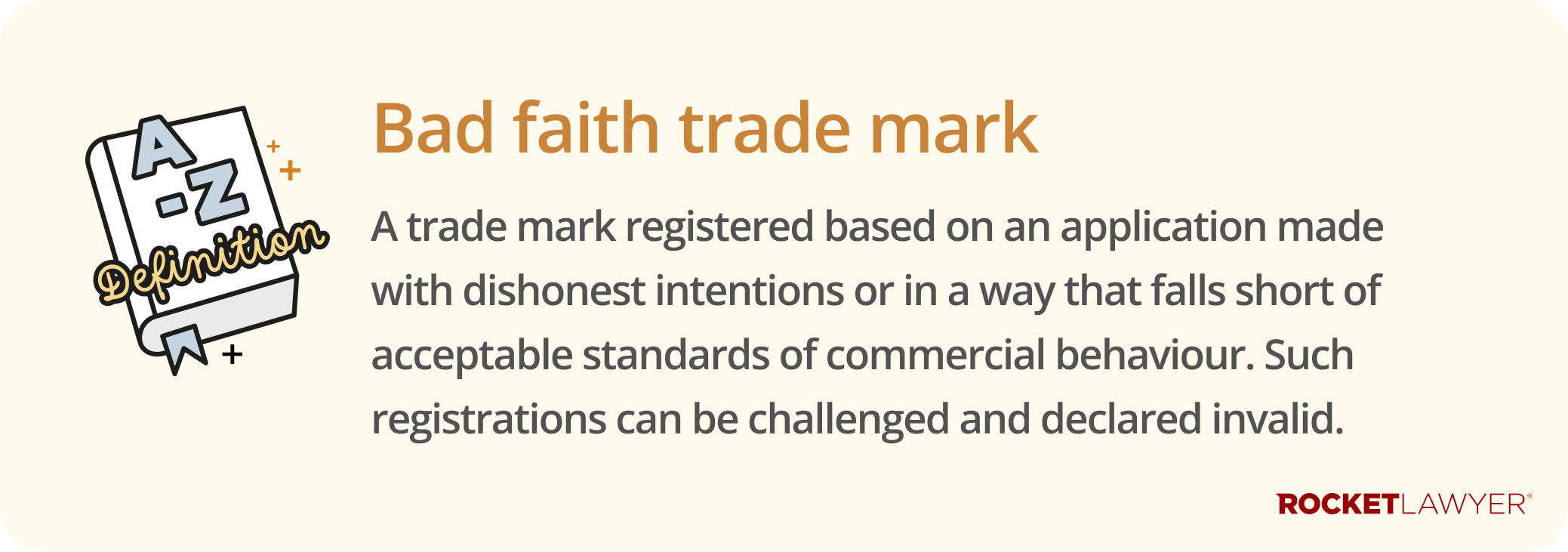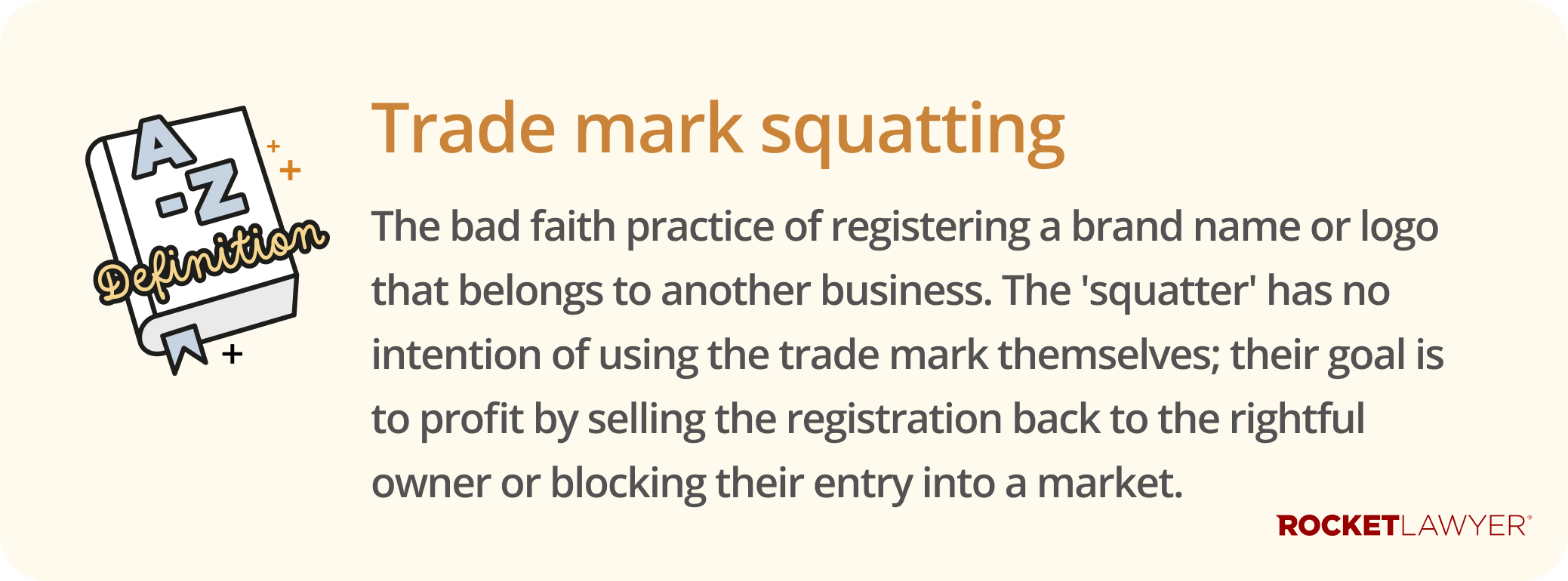What is a bad faith trade mark application?
A trade mark application is made in bad faith if the person applying (the applicant) has dishonest intentions or if their actions fall short of the accepted standards of honest business behaviour. There isn't a single legal definition of bad faith. Instead, the Intellectual Property Office (IPO) and the courts will look at the applicant's state of mind when they filed the application to see if their intentions were genuine.
Since it’s impossible to know exactly what someone was thinking, anyone accusing an applicant of bad faith must provide evidence to support their claim. The burden of proof is on the person making the accusation to show that it's more likely than not that the applicant had a dishonest motive.

Bad faith can generally be divided into two types:
-
bad faith against a third party, such as a known competitor
-
bad faith against the trade mark system itself, where the goal is to misuse the rules

How is bad faith determined?
To decide if an application was made in bad faith, the IPO considers:
-
what the applicant knew at the time of filing
-
the applicant’s intention based on their conduct
It’s a combined test, meaning the IPO looks at both the applicant’s actual intentions (a subjective test) and how their behaviour would be viewed by others in their field (an objective test).
What are some examples of bad faith?
While every case is judged on its own facts, some common patterns of behaviour are often found to be in bad faith.
Trade mark squatting

Trade mark squatting happens when someone registers a trade mark that they know belongs to or is associated with another business, without getting their permission first. The squatter usually has no intention of using the trade mark themselves. Instead, their goal is often to:
-
block the genuine owner from registering their own brand in the UK
-
force the business to buy the trade mark registration from them for an inflated price
-
disrupt the business’s operations
A common tactic is for a squatter to register the name of a foreign brand that has not yet launched in the UK, hoping to cash in when it eventually does.

Applying for an overly broad scope of protection
A red flag for bad faith is when an application covers goods and services that have no commercial logic for the business. This can happen in two ways:
-
applying for an overly broad range of goods and services across various trade mark classes - for example, a local bakery registering its brand name for everything from ‘pastry’ to ‘motors and engines’
-
broadening a monopoly unfairly - for example, registering several minor variations of a logo to stop a competitor from using any similar designs, with no intention of using all the variants themselves
In both cases, it suggests the applicant is trying to unfairly block competitors rather than protect a genuine brand.
Blocking a competitor from the market
This is a clear example of acting in bad faith against a third party. It involves filing for a trade mark with the primary intention of preventing a competitor from registering or using it, rather than for genuine commercial use.
Re-registering a mark (or 'evergreening')

Evergreening is the practice of re-registering the exact same trade mark for the same goods or services every five years to avoid having to prove it's being used. A trade mark can be challenged for non-use if it hasn't been used for five continuous years. By re-registering their mark, some businesses try to reset this five-year clock and avoid having to prove they're actually using it (as they would have to do under the normal trade mark renewal process). This undermines the ‘use it or lose it’ principle and can be considered bad faith.
What happens if a trade mark is registered in bad faith?
If the IPO finds a trade mark application was made in bad faith, it will refuse it. If the mark has already been registered, it can be declared invalid. This means it’s treated as if it were never registered in the first place.
Any interested party can apply to have a trade mark declared invalid on bad faith grounds. This action can be taken at any time, as there is no time limit for making a challenge.
What is the wider impact of bad faith registrations?
Bad faith registrations are costly for competitors and the market as a whole. The potential consequences include:
-
preventing new businesses from entering the market
-
damaging the goodwill and reputation of existing brands
-
stifling fair competition between businesses
-
giving the applicant an unfair competitive advantage
How can you identify bad faith applications?
Bad faith trade marks can seriously impact your brand, so spotting them early is key.
The most efficient way to detect problematic applications is to proactively monitor the trade mark register. This allows you to identify and oppose a bad faith application before it becomes a registered trade mark.
Since bad faith may not be obvious until after registration, it's also a good idea to monitor your competitors’ activities. If a competitor isn't using their trade mark as registered and it's negatively affecting your business, it could be a sign of bad faith.
How can you challenge a trade mark?
If you believe a trade mark has been registered unfairly, you have two main options for challenging it: on the grounds of bad faith or for non-use.

Challenging for bad faith
To challenge a mark for bad faith, you need to file Form TM26(I), an ‘Application for a declaration of invalidity’, with the IPO and pay the required fee. You must provide strong arguments and evidence to prove the owner's intentions were dishonest when they applied for the mark.
Challenging for non-use
Sometimes, a trade mark is registered in good faith, but the business’s plans change and the mark is never used. To keep the register free of unused marks, the law includes a ‘use it or lose it’ rule. If a registered trade mark hasn't been genuinely used for a continuous period of five years, anyone can apply to have it revoked (ie removed from the register).
Genuine use means real, commercial use intended to create or maintain a share of the market. Simply printing a few brochures or using the mark on one or two internal documents isn’t enough. To challenge a mark for non-use, you must file Form TM26(N), an ‘Application to revoke a registration’, with the IPO and pay the required fee. 
If you're ready to protect your brand, you can register your trade mark—it’s FREE for Rocket Legal+ members! If you believe another trade mark has been registered in bad faith or isn’t being used, do not hesitate to Ask a lawyer for guidance.



